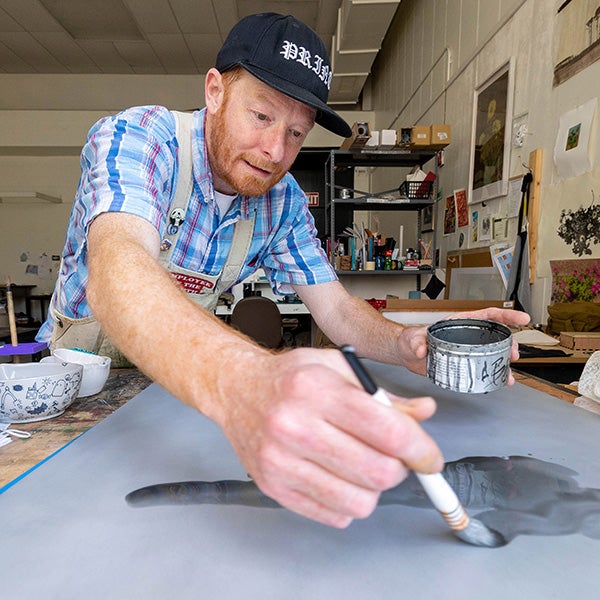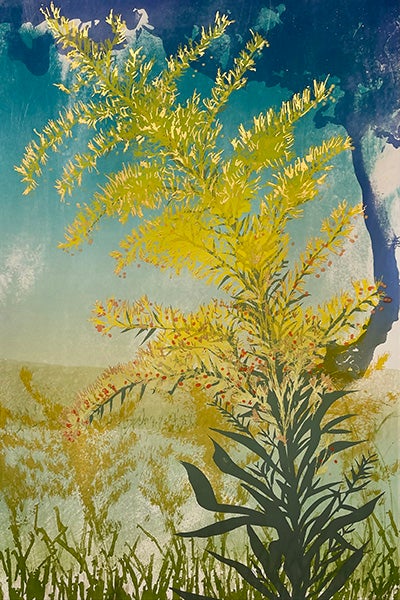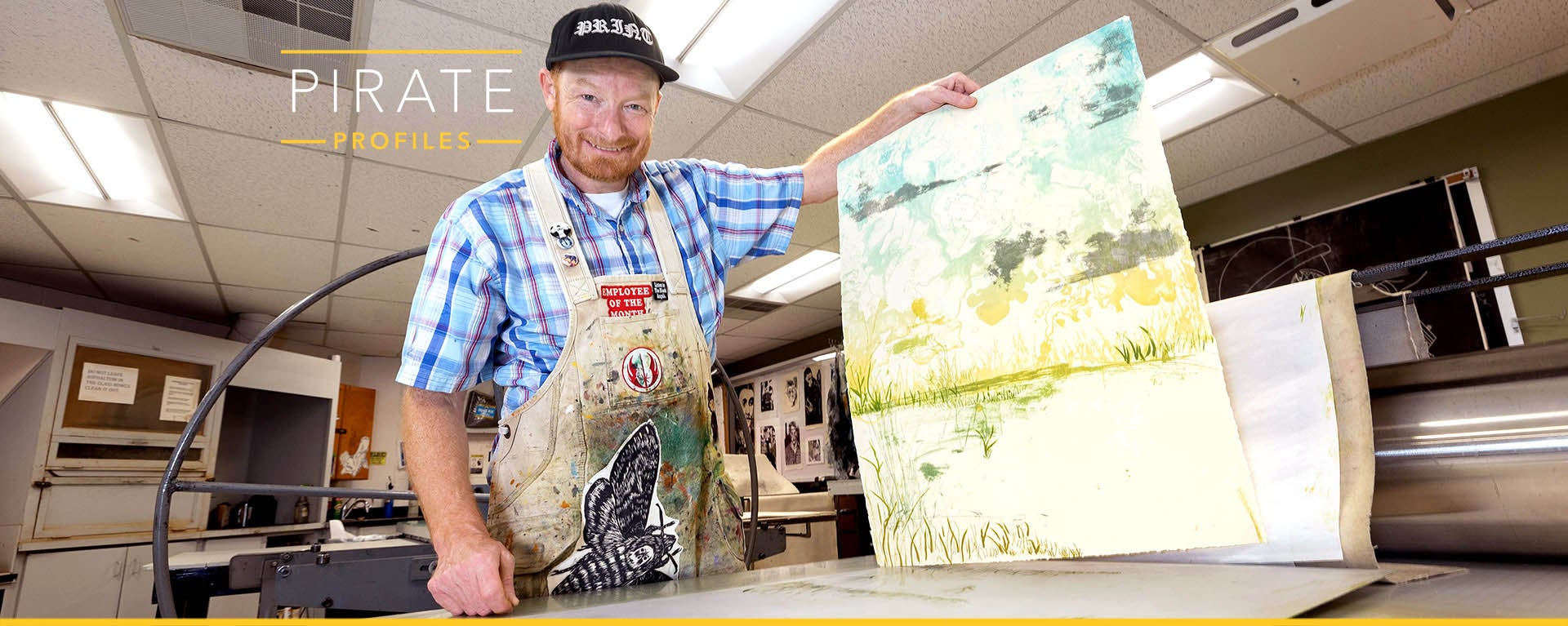Student: Adam Berman
East Carolina University student Adam Berman has spent the last three years working on his master’s degree while teaching printmaking in the School of Art and Design, where 18th and 19th century techniques are incorporated with 21st century technology.
“We have a family here,” Berman said. “We help each other out.”
Printmaking is a labor-intensive process, as Berman puts the full weight of his upper body into pressing a hollow, 10-pound hand inking roller methodically back and forth across paper on a wide table. The steps from beginning to end take 40 to 60 hours for just one finished print.
“The funny thing is this is just like cooking,” Berman said. “It’s 40% prep, 40% cleanup and 20% action. It’s like working in a kitchen.”

ECU student Adam Berman works on a print in Jenkins Fine Arts Center.
Berman knows both well.
He went to culinary school straight out of high school and was a sous-chef in St. Augustine, Florida, before reaching a turning point in his life. He said he got sober at age 32 and decided to go to art school.
He enrolled at a community college where he took prerequisites needed to pursue a bachelor’s degree at the University of North Florida. He thought he would become an illustrator.
“Then in one of the classes someone said over at south campus — at the beach — they’re making prints with this steam roller. I went over, and they’re rolling ink just like this, they’re covered in ink, they’ve got these 4-by-8 wood blocks and they’re all lined up, and they’ve got a potluck going on and there’s music playing, and I thought ‘This is pretty cool.’”
He took a printmaking class and was hooked.
Later, Berman presented his artwork in an open portfolio at a national printmakers conference. ECU faculty member Heather Muise — who has become one of his mentors — stopped at his table and encouraged him to apply to ECU’s master’s program.
Berman applied to four programs, but the most attractive was ECU, which offered an assistantship with a stipend and an opportunity to teach, which he really wanted to do.
Along the way, Berman has created a niche with plants. He had been doing some alternative process photography with cut flowers, creating stanotypes mixed with printmaking. A friend suggested he use wildflowers.

Berman’s artwork combines printmaking and botany.
He started taking pictures of wildflowers and plants, building an archive, doing research and identifying what he had photographed. “Unbeknownst to me, later I found out about an undefined science, a theory called plant blindness,” Berman said. As society has moved from agrarian to service, people know plants from the grocery store instead of what’s outside, where our great-grandmothers, for instance, might use indigenous plants to make seasonings or food.
“This interested me, and I stumbled across something called ethnobotany,” he said. “It was kind of exploratory research, how science used to be. I didn’t know what I was doing. I just started picking them and drying them. The work that I applied to grad school with — I would dry plants and heat them up … and make litho plates of the plants, and then print them in my idea of the environment or the habitat where I found them, loosely, creatively.”
At ECU, he was pushed to do more creative research. He contacted Dr. Claudia Jolls about taking a botany class, then COVID-19 happened. Jolls sent her syllabus and class notes, and Berman kept busy during the pandemic making prints of medicinal plants on a small press he has at home. “The printing was the actual medicine,” he said.
He also connected with Dr. Carol Goodwillie in biology, who was doing a project on kudzu with art faculty member Gabe Duggan. Goodwillie agreed to sit on Berman’s graduate review committee. “She taught me how to key — the flora and fauna of the Carolinas — and it was a big step in my creative research,” Berman said.
He enjoys hiking across the state, and at nearby Goose Greek State Park. “It’s Florida without palm trees,” he said. “The waters are brackish like the St. Johns River where I grew up. I was watching a guy on a flat boat fish for flounder with shrimp, it’s the same.”
While at ECU, Berman received a fellowship to the Arrowmont School of Arts and Crafts in Tennessee, and the College of Fine Arts and Communication Dean’s Merit Award. He is a member of the ECU Print Guild and taught at Emerge Gallery & Art Center. He still loves to cook and has worked catering with Aramark on campus. His other hobbies are drawing and skateboarding.
With ECU instructor Gerald Weckesser’s guidance, Berman built 40 cherry and walnut frames for his thesis show, now at the Greenville Museum of Art. “Graduating with my MFA is an incredible milestone in my life,” Berman said. “Having the credentials to teach printmaking at the collegiate level means a lot to me.”
Following graduation, Berman will move to New Mexico for the Tamarind Institute’s collaborative printer training program, a highly competitive program that accepts up to eight students a year. The intensive full-time program is the only one in the U.S. that offers a master printer apprentice program.
Berman’s work is available through his online store.
STATISTICS
Name: Adam Noah Berman
College: College of Fine Arts and Communication
Major: Master of Fine Arts in printmaking
Age: 46
Classification/Year: Graduate student
Hometown: Jacksonville, Florida
Hobbies/interests: Hiking, plants, cooking and printmaking
Clubs and Organizations: ECU Print Guild
FAVORITES
Favorite hangout: William B. Umstead State Park
Favorite place on campus: Jenkins Fine Arts Center
Favorite place to eat: Publix
Favorite class: Printmaking
Professor who influenced you the most: Heather Lynn Muise
Favorite TV show: “Avatar: The Last Airbender”
Favorite band/musician: Radiohead
Favorite movie: The Star Wars series
Favorite book: Calvin and Hobbes series
MOTIVATIONS
Dream job: National Geographic wildlife photographer
Role model: Julienne Beblo
Your words to live by: The more you give the more you get.
What advice do you have for other students? Don’t take yourself so seriously.
What is something cool about ECU that you wish you knew during your first year? The fourth floor of the library.
